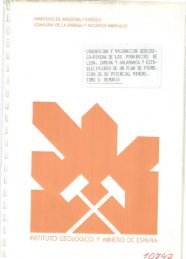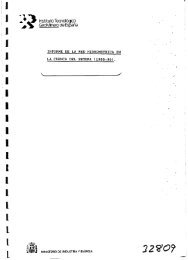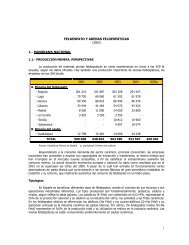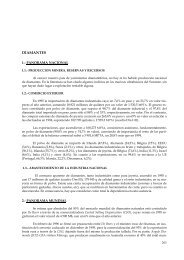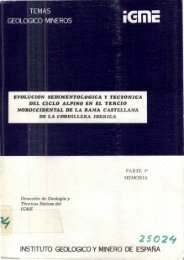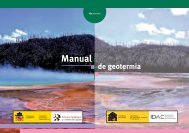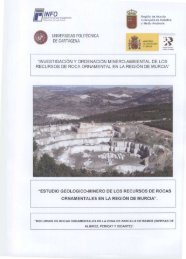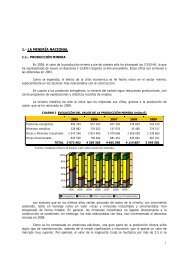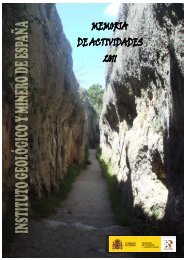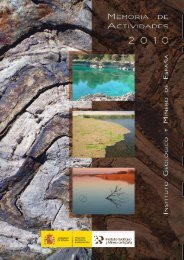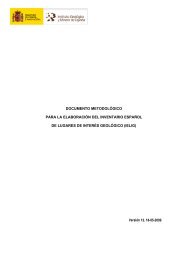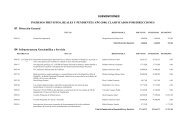6. Rotational kinematics of the Boltaña anticline - Instituto Geológico ...
6. Rotational kinematics of the Boltaña anticline - Instituto Geológico ...
6. Rotational kinematics of the Boltaña anticline - Instituto Geológico ...
You also want an ePaper? Increase the reach of your titles
YUMPU automatically turns print PDFs into web optimized ePapers that Google loves.
<strong>Boltaña</strong> <strong>kinematics</strong> Mochales, 2011<br />
Figure 9. Tectonic model <strong>of</strong> <strong>the</strong> South Pyrenean Zone (Cámara and Klimowitz, 1985). This model describes a<br />
footwall sequence <strong>of</strong> cover thrusting propagated from E to W.<br />
2.5. The South Pyrenenan Central Unit (SPCU)<br />
The SPCU is characterised by a set <strong>of</strong> allochthonous imbricate thrust sheets and associated<br />
south verging folds. They were emplaced over <strong>the</strong> autochthonous rocks <strong>of</strong> <strong>the</strong> Ebro foreland basin<br />
with thrusting propagating southwards in a piggyback sequence (Séguret, 1972; Garrido-Megías,<br />
1973; Cámara and Klimowitz, 1985; Puigdefàbregas et al., 1991; Muñoz, 1992). These thrust sheets<br />
are detached along Triassic evaporites and incorporate Mesozoic and Tertiary cover materials. From<br />
Early Cuisian, <strong>the</strong> emplacement <strong>of</strong> <strong>the</strong> South Pyrenean central Unit (SPCU) produced <strong>the</strong><br />
fragmentation <strong>of</strong> <strong>the</strong> South Pyrenean Basin and conditioned subsequent sedimentation. The geometry<br />
<strong>of</strong> <strong>the</strong>se imbricate thrusts is strongly conditioned by <strong>the</strong> structural inversion <strong>of</strong> <strong>the</strong> Cretaceous<br />
extensional basin.<br />
In <strong>the</strong> SPCU, <strong>the</strong> units <strong>of</strong> Bòixols, Cotiella, Montsec and Marginal Sierras can be<br />
distinguished (Séguret, 1972). Originally, Séguret (1972) included <strong>the</strong> Pedraforca sheet, which in <strong>the</strong><br />
present description is included in <strong>the</strong> Eastern South-Pyrenean Zone. The Bòixols-Turbón Unit has a<br />
thick Mesozoic <strong>of</strong> about 5000 m, including Triassic, Jurassic and Lower Cretaceous rocks and a thin<br />
Paleocene and Lower Eocene strata with local Upper Eocene-Oligocene conglomerate cover (García-<br />
Senz, 2002), unconformably overlying <strong>the</strong> previous marine sequence, and subsequent to <strong>the</strong> main<br />
folding stage. Compressive deformation is here recorded from Late Santonian (Late Cretaceous) as a<br />
consequence <strong>of</strong> <strong>the</strong> inversion <strong>of</strong> Cretaceous extensional basins (Garrido-Megías, 1973; Simó 1985;<br />
Bond and McClay, 1995; García-Senz, 2002). This unit was passively transported southwards on <strong>the</strong><br />
Montsec thrust sheet, which was active from Ilerdian to Cuisian times (Garrido-Megías, 1972b;<br />
Nijman and Nio, 1975; Farrell et al., 1987; Vergés and Muñoz, 1990; Teixell and Muñoz, 2000). The<br />
Cotiella Unit present an Eocene footwall with marked NNW-SSE trending cleavage, also present in<br />
<strong>the</strong> Cretaceous marls <strong>of</strong> <strong>the</strong> hangingwall (Séguret, 1972). It is detached in <strong>the</strong> Keuper facies and its<br />
origin is likely associated with an oblique ramp (Martínez-Peña, 1991). Several authors consider <strong>the</strong><br />
emplacement <strong>of</strong> <strong>the</strong> Bòixols-Cotiella nappe isochronous during <strong>the</strong> Late Cretaceous as a consequence<br />
23



